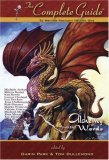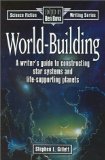Before you can get your fantasy world to come alive in your readers mind you have to first get it to come alive in your own mind. It has to be tangible and real. And you have to see it before you can expect your reader to see it. So how do you do this? I have three suggested methods for bringing your vision of a world to life.
Draw maps of your world
If you read a lot of epic fantasy chances are you have looked at the maps that come with many of these books. They are a wonderful addition to the writing. They bring a visual reality to the world contained in the novel and they are not an afterthought to the novel. They are a valuable part of the novel reading experience.
Maps are not just for the reader though. They can serve a very useful function to you as a writer. Chances are good that your main character or main characters have to travel around the world you have created. Where are the rivers? How far apart are the cities and towns? What are the main features of the landscape? Are there mountains? How long would it take your character to walk from one place in the world to another place in the world. A good map can help you answer all these questions.
Too often maps are almost an afterthought. The story is written and then the map is drawn to fit the story. You should turn this approach on it’s head and draw the maps early in the writing process.
A map or even a series of maps can ground your story in a sense of reality. It can also spur new ideas in the story. The visual layout of a map can bring out new ideas. Does the map feel like it is missing something. Does it feel natural for a lake to be at the base of a mountain? Draw it in and see if it brings a new chapter to your story. Are there two rivers that meet? What should be at this meeting point? Is there a city? Maybe there is a dark forest. Maybe these new terrain features will play a role in your story.
Maps are something that a reader often refers to. A map is a bonus in a novel and whenever there is a map in a novel that I am reading the map pages are deeply dog-eared. It brings a different part of the readers brain into the story. Don’t neglect maps and don’t save them as an afterthought. Use them to their fullest potential. Even if you don’t have much skill with drawing, your map may be good enough to actually use in the final print version. It is the roughest maps that look like they are hand-drawn that are the best accompaniment to a fantasy story.
Make 3d scenes and dioramas for your world
I am a diorama maker. I love creating little scenes with wizards, barbarians and all sorts of evil creatures. When I wrote my first novel I took on the ambitious project of creating a tabletop diorama for one particular area of the world I had created. It was a project that covered a custom built table that was seven feet long and four feet wide and it took a lot of time to build but the reward for this project was also big. Having an actual layout of a scene in the novel allowed me to breathe life into the novel. I could now see the terrain and the characters as they moved over it. I could envision the weather and the plant life. It made it much easier for me to draws pictures in my reader’s minds. You don’t have to do a project as ambitious as the one I did, you could just do a small scene but this type of world building in a visual sense will add a sense of depth to your writing.
Create a video game that you can walk around in
This sounds like a lot of work, and a couple of years ago this was not an option for a hobbyist; but today the technology and tools are here that allow you to actually create some pretty amazing worlds in just a few hours. There are plenty of free resources that allow you to make indoor and outdoor worlds without spending a penny. You just need to invest some time. The technology has developed to the point where it is almost plug and play. Let me give you an example. You can sketch out in a world building tool a city. You can make it a certain size, place terrain and buildings in it then add all sorts of pre-made extras. In a weekend you can have a small and complete world that you can actually use a pre made character to walk around in your world.
There are two distinct benefits to putting the effort into doing this. First of all you can build a pseudo realistic rendition of an area of your story and this can help you to visualize it better. And visualizing it better means you will describe it to your reader better. But secondly, and even more importantly, the process of creating this world in a medium other than pencil and paper will take your imagination and creativity to new levels. As you are building your world you will see it in a new way. This will bring you new ideas, ideas that you would have never thought of with just a word processor.
I have worked with several different software suites for creating worlds and one of the new ones is the Kaneva game platform. I haven’t used it yet but it looks very appealing and very user friendly. If you use this platform to make a world you can even invite other people to come and explore it with you. Wouldn’t that be something? You can tell them it is the world that your novel takes place in.
Epic fantasy and fantasy writing is, by its very nature, a creative art form. But too often we as writers in the genre tend to focus too much on either the physical action or the social interaction in the story. You must never forget that your story takes place in a world you created. And this world is the ground to which your whole story is tethered. It must be solid as stone and be clearly envisioned by you. And it must be clearly and vividly expressed to your reader. Building a physical representation of your created world brings it to a new level and helps you convey its sense of reality to your reader.
I have lots more articles on writing fantasy here

On Writing - Short and snappy as it is, Stephen King's On Writing really contains two books: a fondly sardonic autobiography and a tough-love lesson for aspiring novelists. The memoir is terrific stuff, a vivid description of how a writer grew out of a misbehaving kid. You're right there with the young author as he's tormented by poison ivy, gas-passing babysitters, uptight schoolmarms, and a laundry job nastier than Jack London's. It's a ripping yarn that casts a sharp light on his fiction. This was a child who dug Yvette Vickers from Attack of the Giant Leeches , not Sandra Dee. "I wanted monsters that ate whole cities, radioactive corpses that came out of the ocean and ate surfers, and girls in black bras who looked like trailer trash." But massive reading on all literary levels was a craving just as crucial, and soon King was the published author of "I Was a Teen-Age Graverobber." As a young adult raising a family in a trailer, King started a story inspired by his stint as a janitor cleaning a high-school girls locker room. He crumpled it up, but his writer wife retrieved it from the trash, and using her advice about the girl milieu and his own memories of two reviled teenage classmates who died young, he came up with Carrie . King gives us lots of revelations about his life and work. The kidnapper character in Misery , the mind-possessing monsters in The Tommyknockers , and the haunting of the blocked writer in The Shining symbolized his cocaine and booze addiction (overcome thanks to his wife's intervention, which he describes). "There's one novel, Cujo , that I barely remember writing." - Short and snappy as it is, Stephen King's On Writing really contains two books: a fondly sardonic autobiography and a tough-love lesson for aspiring novelists. The memoir is terrific stuff, a vivid description of how a writer grew out of a misbehaving kid. You're right there with the young author as he's tormented by poison ivy, gas-passing babysitters, uptight schoolmarms, and a laundry job nastier than Jack London's. It's a ripping yarn that casts a sharp light on his fiction. This was a child who dug Yvette Vickers from Attack of the Giant Leeches , not Sandra Dee. "I wanted monsters that ate whole cities, radioactive corpses that came out of the ocean and ate surfers, and girls in black bras who looked like trailer trash." But massive reading on all literary levels was a craving just as crucial, and soon King was the published author of "I Was a Teen-Age Graverobber." As a young adult raising a family in a trailer, King started a story inspired by his stint as a janitor cleaning a high-school girls locker room. He crumpled it up, but his writer wife retrieved it from the trash, and using her advice about the girl milieu and his own memories of two reviled teenage classmates who died young, he came up with Carrie . King gives us lots of revelations about his life and work. The kidnapper character in Misery , the mind-possessing monsters in The Tommyknockers , and the haunting of the blocked writer in The Shining symbolized his cocaine and booze addiction (overcome thanks to his wife's intervention, which he describes). "There's one novel, Cujo , that I barely remember writing."


Alchemy with Words: The Complete Guide to Writing Fantasy vol 1 (The Complete Guide Series)
 
World Building (Science Fiction Writing) This book is designed to give science fiction writers the solid grounding they need in real science to make their fictions read like fact. World Building is a blueprint in words, calculations, tables and diagrams to help writers transport readers from one world to another. This book is designed to give science fiction writers the solid grounding they need in real science to make their fictions read like fact. World Building is a blueprint in words, calculations, tables and diagrams to help writers transport readers from one world to another. |
![]()



![]()

